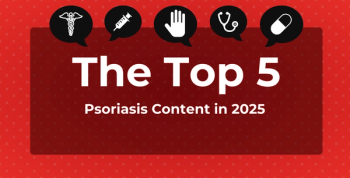
Prevalence and Burden of Psoriasis and Metabolic Syndrome
A review of the prevalence and burden of psoriasis and metabolic syndrome.
Transcript
Peter L. Salgo, MD: Let’s go to the guy who holds all the purse strings. You’ve got all the good data here, and we haven’t really challenged you to help us here yet. What percentage of patients with psoriasis have metabolic syndrome as a comorbidity?
Peter Dehnel, MD: A couple of thoughts in general. And I love this discussion because this is at a level of information that few of us when we were going through medical school ever got. And this is an emerging and evolving body of knowledge that I think that viewers and clinicians in general need to know. Because psoriasis is, in general, maybe 1% to 3% of the population, which may sound small until when you look at the US population of 350 million, you’re suddenly talking about 10 million people with psoriasis.
Peter L. Salgo, MD: I was going to say that’s an enormous number.
Peter Dehnel, MD: That is when you put it in the right context, when you discuss it. And then if you look at the association between psoriasis and metabolic syndrome, at least according to some statistics, it’s about 40%. With obesity in the country maybe being 30%, we do know there’s an additional risk factor for metabolic syndrome in psoriasis. And when you suddenly start talking about 2 chronic diseases that you’re trying to manage in the population sense, it really puts a burden on the healthcare system.
Peter L. Salgo, MD: Let’s do the math, if I can do it right. Forty percent of 10 million people is 4 million people.
Steven Feldman, MD, PhD: Yes.
Peter L. Salgo, MD: Did I do that right? That’s a lot of folks.
Steven Feldman, MD, PhD: It can be, yes.
Peter L. Salgo, MD: I know it simply is, especially if you’re one of that 4 million.
Steven Feldman, MD, PhD: The other thing I think is important is that if patients get these comorbidities earlier in life, not only is the prevalence higher but the duration of exposure to these comorbidity states is a problem. They may be in their 30s and already showing signs of metabolic distress and metabolic syndrome, where you may not typically have picked it up until someone is more in their 40s, 50s, if you will.
Peter L. Salgo, MD: How much is this costing? What’s the economic burden of all this?
Steven Feldman, MD, PhD: We’re into the billions—billions with a B.
Peter L. Salgo, MD: That’s federal budget numbers here.
Joel Gelfand, MD, MSCE, FAAD: In terms of both, you can look at the cost to society as a whole or the US healthcare dollar, which is substantial to begin with, obviously. But to the individual person, those numbers really start to make sense because they may have higher co-pays and higher deductibles, which do affect their bottom line as a family. And they may make treatment choices that may not be in their best long-term interest. So you start looking at the different options that are available for people in treatment. Some of these are extremely expensive, but they may be very effective in terms of managing the disease. But then how do you reconcile that with your need to pay the rent, or pay your mortgage, or those kind of things?
Peter L. Salgo, MD: Or from your perspective I would guess, to pay for other people in your plan who have other expensive diseases.
Steven Feldman, MD, PhD: With health insurance, there’s a lot of different people who pay for that and it impacts everyone. I think that, talking about insurance, it’s very helpful to define exactly what program you’re in. Now if you’re in Medicaid, that’s one payment source. If you have a large employer who’s providing your insurance, that’s another payment source, and it may be in your employer’s best interest to have a very healthy, effective workforce. So they would be more interested in paying for some of the newer treatments.
Joel Gelfand, MD, MSCE, FAAD: I can tell you that patients worry about this a lot. Even when they’re able to get on a successful treatment course of therapy that works well for them, they worry that they are going to lose access to that treatment because they’re going to lose access to insurance or their insurance policy will change, and things of that nature. And we know for our patients, both from a research perspective, from studies we’ve done, that when people start losing control of their disease, disease comes back, that there’s a penalty to pay, that they have bigger impacts on their health and quality of life and disability than they had before we were treating that disease.
Peter L. Salgo, MD: To make this the reductio ad absurdum, if you will, I give you a pill that costs a trillion dollars and it will cure you, but that means that nobody else can get healthcare. Where do you put that line? How do you make that decision? There’s a famous problem in ethics. There’s a train coming down the track and there’s a kid on 1 branch and an enormous group of other people on the other track, and you can either switch the train to kill the kid, or switch the train to kill everybody else. How do you make that decision? You have to make that, don’t you, as an insurer?
Peter Dehnel, MD: Well, we don’t have to make any decisions because we just say what is covered and what is not.
Peter L. Salgo, MD: Oh, but that’s disingenuous, come on. I can hear people at home throwing things at the TV.
Peter Dehnel, MD: Well, they may be right now throwing things. But I think, though, to your point, is that we have to, as a society, really look at what is the most cost-effective and efficient treatment for people. And I think that one of the things that will be very helpful is to get more research. Are there other treatment modalities that are as effective but less costly? Because it’s not just the insurance company. We just, if you will, pay the bill. Somebody else is oftentimes providing the funds to pay the bill.
Peter L. Salgo, MD: But somebody’s got to make that decision. Somebody made the plan, somebody set up the logic tree, if you will. We’re going to do this, we’re not going to do this, you’re going to have to apply for this, we’re going to make this difficult to get. At some level somebody does that.
Peter Dehnel, MD: That’s right. And who does that depends on what insurance plan they’re under or who’s providing the coverage. For example, a state government through Medicaid may be having some influence on that. It may be a large employer who’s making some influence with that.
Newsletter
Stay ahead of policy, cost, and value—subscribe to AJMC for expert insights at the intersection of clinical care and health economics.





























































